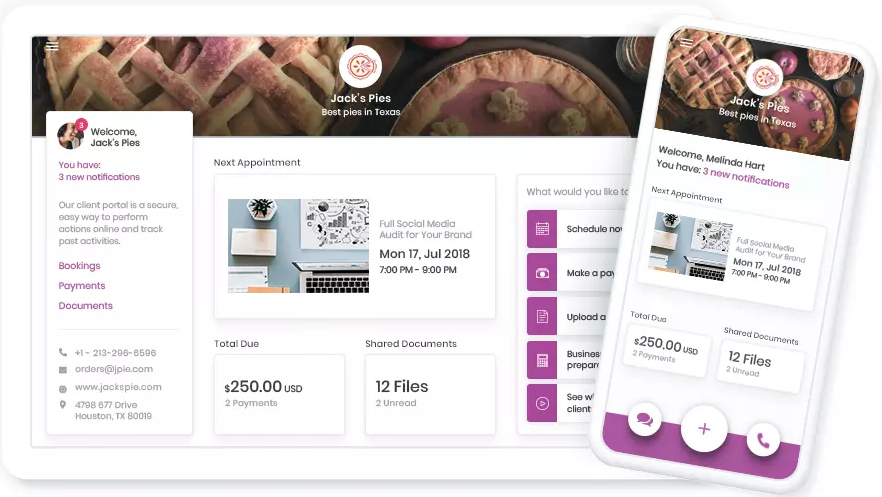Learn how to boost efficiency across your whole company with our top five research-backed tips and tactics.
It isn’t easy to come up with management tips that actually work. Every company (and every workforce) is different. A tactic or strategy that leads to fantastic results in one scenario might be a complete flop in another.
What’s more, most of the information published online isn’t backed by research. A quick perusal of the top results in Google for a term like “management advice” will quickly have you scratching your head in bewilderment.
So what makes these tips different? First, they’re largely supported by evidence or extensive client testimonials. Second, they’re very easy and inexpensive to test. Determining whether or not they’re a fit for your business will be a straightforward process.
With all that in mind, let’s dig in and take a look at five underused but highly effective ways of boosting efficiency and productivity across your whole company.
1. Offer a Client Portal
Client portals are like mini member’s areas on your site. Your customers can log in and carry out a range of tasks that would typically take up hours of your employees’ time.
Consider a routine job such as appointment scheduling. While it might only take a few minutes to manually book an appointment via phone or email, when this process is repeated multiple times over the course of days and weeks, it quickly starts to represent a major cost.
The vcita client portal app is an example of this kind of software. It allows businesses to add easy-to-use client areas to their websites. Once a user is logged in, they can schedule appointments, make payments, upload important documents, contact customer support, and more. All without any direct input from a member of your team.
2. Go Paperless and Automate Your Document Workflows
Managing paperwork is a cumbersome process. And expenses can quickly add up. Research shows that when you account for labour and storage in conjunction with raw materials, it costs a company an average of $20 to file a paper document. Think about how many contracts, invoices, receipts, proposals, etc. a typical business files over the course of a single year and you’re looking at some pretty significant expenditure.
One way of tackling this problem head-on is by going paperless. Contract management apps, which are suitable for businesses of all sizes, can be used to take care of nearly every part of your document workflow, from creation to final approval.
An additional layer of features, like template libraries, automation options, collaboration areas, and secure online storage of documents, can bolster the efficiency of your paperless office even more.
3. Take a Science-Backed Approach to Employee Wellness
Employee wellness programs are all the rage nowadays. They’ve been touted by business leaders like Arianna Huffington, Oprah Winfrey, and Warren Buffet, to name just a few. But are they effective? The research seems to paint a more nuanced picture. In particular, a short-term study conducted by Harvard University suggests that not all popular interventions produce the desired results.
This isn’t to say that all wellness initiatives are bad, however. Other studies indicate that they do have wide-ranging positive effects. The key point to understand is that the evidence is mixed. That’s why it’s essential to research wellness initiatives thoroughly and opt for the activities and approaches that have been proven effective. You should also conduct your own in-house tests to ensure that you are generating a positive return-on-investment.
4. Gather Qualitative Employee Feedback
Employees are usually an excellent source of insights about how to improve the day-to-day operations of your company. They have direct experience of internal processes and will understand nuances and small inefficiencies in systems that might otherwise be very difficult to pinpoint.
Many managers and CEOs make the mistake of collecting only quantitative data focused on performance metrics like number of sales, units produced, client satisfaction scores, and so on.
But by collecting feedback directly from employees, you can gain a much fuller picture of the reasons that performance metrics might be lacklustre. What’s more, qualitative feedback is very inexpensive to gather - think surveys and open questions - and then review. Consider making the process anonymous to ensure honest responses.
5. Embrace Remote Work
COVID-19 has spurred a global shift towards remote working. Whether or not these changes stick remains to be seen. But what’s undeniable is the range of benefits that many companies have seen after allowing their employees to work from home.
When it’s done well, remote working can boost productivity, reduce costs, and increase general wellbeing. Offering employees greater flexibility over their working habits is also an excellent away to appeal to (and keep) the best talent.
Most businesses were forced into developing an infrastructure that supported remote working. Now is an excellent time to think about how you can build on it and leverage any insights for future success.
Conclusion
In most cases, boosting efficiency is about looking for incremental gains. Most managers, CEOs, and business leaders are already running reasonably efficient companies - they wouldn’t be in business if they weren’t.
It’s in the small changes that the opportunities are to be found. On their own, their impact might be minimal. But taken together, they can have a significant effect. Keep that in mind when implementing the tips described above.













